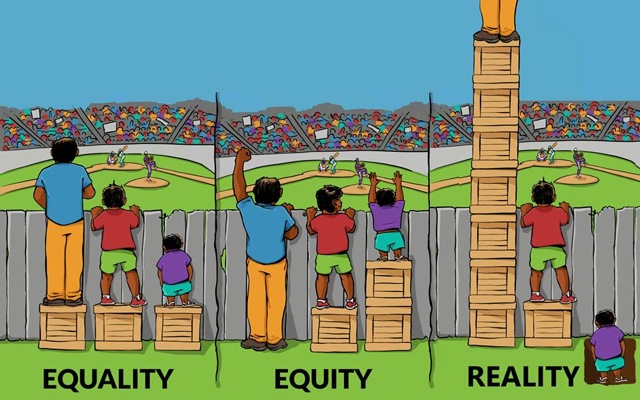A common set of images used to illustrate the difference between formally equal treatment and supports that help individuals reach the “universal goal” are those that feature people behind a fence and trying to catch the view on the other side.
The fencing imagery is often framed as distinguishing between “equality,” meaning strictly “equal treatment,” and “equity” or fairness. In the ‘“equality” version of the image, people of different heights have equally sized boxes to help lift them in an aid to see above the fence. Each person is given an identically sized box to help them see over the fence—but only the taller person is able to see over the fence when they stand on the box. The same box doesn’t help people of different heights see over the fence. In this way the visual metaphor demonstrates the idea that treating “different people” equally is not a solution. When we map this image onto the concept of targeted universalism it may be said that the universal strategy of distributing identical boxes to different people did not enable everyone to reach the goal.
Targeted universalism does advocate for different people receiving different strategies or greater resources—in this case everyone could see over the fence if they had different sized boxes or more than one box. However, this image doesn’t serve as the best metaphor for targeted universalism. From this analysis of the image we presume that the universal goal was to make it so that everyone could see over the fence.
A more careful analysis can point out the fact that the fundamental goal would be to remove the fence—and the goal would be to have everyone see and enjoy the baseball game. If the fence were gone, no one would need to stand on boxes—whether that’s one or more boxes. This is definitely a more durable solution and doesn’t require the perpetual distribution and production of boxes.
Removing the fence is universalistic—helping everyone to see the game—and does not single out a particular group based on height. This enables strategy design that solves the problem for the shortest people and the tallest people. In so doing, figuring out how to take apart the fence does not focus on the “deficits” of individual people. Taking apart the fence is also a structural—rather than an individual—fix, is more durable, and benefits everyone.

Image sources: Variations of these images have been created by Craig Froehle, Angus Maguire, the Center for Story-Based Strategy and the Interaction Institute for Social Change.
Reading even more into this metaphor, we can appreciate the role of institutions, structures, and systems. One version of this image sometimes reconstructs the fence—see the final figure above. The wooden privacy fence has been replaced by a chain link fence. This is also a false solution—people can see the game but there is an enduring structural artifact that keeps people out of the facility. Certainly, in an image without a fence, we imagine that the team up for bat would usher the new game attendants to the bleachers and off the expanded field. Changing a literal structural barrier can make the existing rules of the game add people to the bleachers. There is a presumption in this figure that everyone wants to see a baseball game—an exceptionally long, and some may say boring, game. If more people were allowed into the game as spectators, then there is more potential for their desires to sway decisions. Maybe the publicly funded sports field can begin to host many different kinds of sports of interest to different people.



